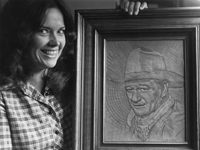Out of the vault and into the market, nearly 750 items once belonging to actor John Wayne are now up for view and for sale.
John Wayne Enterprises is offering film memorabilia and personal items from the family’s collection during live auctions Oct. 3-6 in Los Angeles. Special public previews of available items spanning the 60-year acting career of The Duke took place last month in California and New York, and now can be seen online.
Auction items include Waynes Best Actor Golden Globe award, for his 1969 portrayal of Rooster Cogburn in True Grit. The signature eye patch he wore in the movie is also up for sale, along with the cowboy hat he wore in the 1975 sequel, Rooster Cogburn. Notably, a re-make of True Grit, with Jeff Bridges portraying the hard-drinking U.S. Marshall Cogburn, is stirring memories of John Wayne.

Westernfilm icon John Wayne is a favorite subject of all kinds of artists at any age.
photo by Vicki Barker
|
The first-ever single-owner auction of The Duke’s personal collection will also offer some of his personal correspondence with U.S. presidents, more than 50 film scripts with handwritten notations, a Stetson cowboy hat he wore in the 1953 film Hondo, a costume he wore in the 1949 film Sands of Iwo Jima, Wayne’s American Express card, driver’s license, and more.
Wayne’s youngest son, Ethan, 49, selected the items for auction. Ethan is from John Wayne’s third marriage and was named after a character in director John Ford’s 1956 western, The Searchers, filmed in Monument Valley.
A percentage of proceeds from the auction will benefit the John Wayne Cancer Foundation. Sold items will include certificates of authenticity from Heritage Enterprises. Pre-sale prices range from $100 to $50,000.
Cancer took Wayne’s life 32 years ago, a few years after he’d been in Utah filming near Kanab. A co-star, Susan Hayward, also later died of cancer.
The silver-screen icon of western movies, John Wayne and often other members of his family walked Moab’s streets free of hassle from papparazi and autograph-seekers, making friends with many local residents during local filming that boosted the economy in the 1940s, 50s and 60s.
The room where he stayed a number of times at The Apache Motel is named and maintained much as it looked when he visited, and the lobby has photographs of action scenes from films he starred in locally. A life-size cut-out of The Duke dominates an exhibit that also includes movie scenes at Grand County’s Western Heritage and Film Museum at the Red Cliffs Resort on Highway 128.
Wayne died at age 72 in 1979 but remains an internationally popular image of the all-American rough-and-tumble individualist with high moral standards. He served in the U.S. military and played heroic roles in a number of early-cavalry and army films. He was in 170 films and holds the record for the most leading roles by an actor, at 142.
Wayne’s first credited screen role was in a 1929 musical comedy, Words and Music. His last role was in The Shootist, filmed in 1976.
In 1939, director John Ford cast Wayne in a role that set the mold for the cowboy-gunfighter in Stagecoach, a masterwork that revived and elevated the western genre to a new level of popularity. Filmed in Monument Valley, the movie launched The Duke to superstardom as The Ringo Kid, a boyish gunfighter who tries to charm a sheriff from returning him to jail after a stagecoach journey through hostile territory.
Many residents of Moab and other rural Utah towns -- including native Americans recruited from the Navajo Reservation -- won bit parts and or served as extras in later John Wayne films: 1948’s Fort Apache, 1949’s She Wore A Yellow Ribbon,1950’s Rio Grande, 1956’s The Searchers, 1959’s Rio Bravo, 1961’s The Comancheros, and 1963’s The Greatest Story Ever Told.
Following their father’s death, Wayne’s children established Wayne Enterprises to preserve and protect through trademarks and control of market infringements the images, name and likeness of their father. Ethan Wayne is manager of Wayne Enterprises, which helps fund the John Wayne Cancer Institute and affiliate St. John’s Health Center in Santa Monica, Calif.
Editor’s Note: Sources for this story and art included Where God Put the West: Movie-Making in the Desert (author Bette L. Stanton, 1994), Cowboys & Indians magazine (July 2009), The Dallas Observer (September 2011), American Profile magazine (Aug. 28-Sept. 5, 2011), (September 2011), and personal collection of the writer.
|
